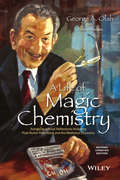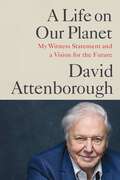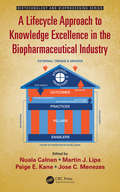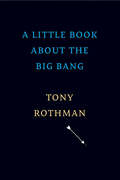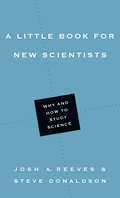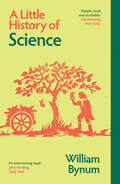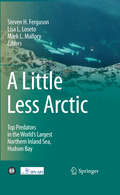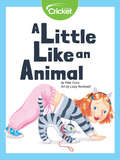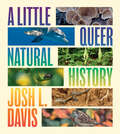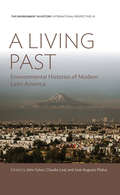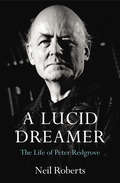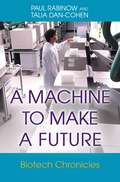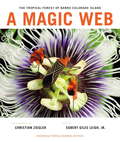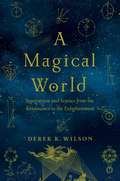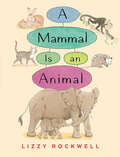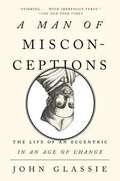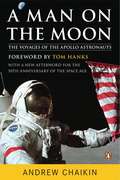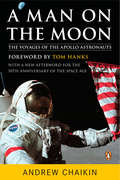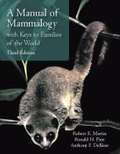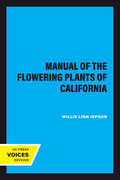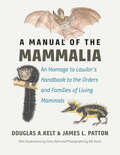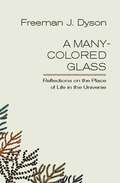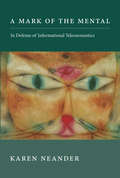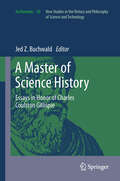- Table View
- List View
A Life of Magic Chemistry
by George A. Olah Thomas MathewThe autobiography of a Nobel Prize winner, this book tells us about George Olah's fascinating research into extremely strong superacids and how it yielded the common term "magic acids." Olah guides us through his long and remarkable journey, from Budapest to Cleveland to Los Angeles, with a stopover in Stockholm. This updated autobiography of a Nobel Prize winner George A. Olah: Chronicles the distinguished career of a chemist whose work in a broad range of chemistry areas, and most notably that in methane chemistry, led to technologies that impact the processing and utility of alternative fuels Is based on Olah's work on extremely strong superacids and how they yielded the common term, "magic acids" Details events since the publication of the first edition in 2000 Inspires readers with details on Dr. Olah's successful recent research on methane, intended to help provide a solution to "the oil problem" ical" carbocations - such as the norbornyl cation, which can be depicted as cationic character delocalized over several bonds. In recent years, his research has shifted from hydrocarbonsand their transformation into fuel to the methanol economy. He has joined with Robert Zubrin, Anne Korin, and James Woolsey in promoting a flexible-fuel mandate initiative.
A Life on Our Planet: My Witness Statement and a Vision for the Future
by Sir David AttenboroughIn this scientifically informed account of the changes occurring in the world over the last century, award-winning broadcaster and natural historian shares a lifetime of wisdom and a hopeful vision for the future.See the world. Then make it better.I am 93. I've had an extraordinary life. It's only now that I appreciate how extraordinary. As a young man, I felt I was out there in the wild, experiencing the untouched natural world - but it was an illusion. The tragedy of our time has been happening all around us, barely noticeable from day to day -- the loss of our planet's wild places, its biodiversity. I have been witness to this decline. A Life on Our Planet is my witness statement, and my vision for the future. It is the story of how we came to make this, our greatest mistake -- and how, if we act now, we can yet put it right.We have one final chance to create the perfect home for ourselves and restore the wonderful world we inherited.All we need is the will do so.
A Lifecycle Approach to Knowledge Excellence in the Biopharmaceutical Industry (Biotechnology and Bioprocessing)
by Nuala Calnan Martin J Lipa Paige E. Kane Jose C. MenezesThis book addresses the rapidly emerging field of Knowledge Management in the pharmaceutical, medical devices and medical diagnostics industries. In particular, it explores the role that Knowledge Management can play in ensuring the delivery of safe and effective products to patients. The book also provides good practice examples of how the effective use of an organisation’s knowledge assets can provide a path towards business excellence.
A Little Book about the Big Bang
by Tony RothmanA concise introduction to the greatest questions of modern cosmology. What came before the big bang? How will the universe evolve into the future? Will there be a big crunch? Questions like these have no definitive answers, but there are many contending theories. In A Little Book about the Big Bang, physicist and writer Tony Rothman guides expert and uninitiated readers alike through the most compelling mysteries surrounding the nature and origin of the universe. Cosmologists are busy these days, actively researching dark energy, dark matter, and quantum gravity, all at the foundation of our understanding of space, time, and the laws governing the universe. Enlisting thoughtful analogies and a step-by-step approach, Rothman breaks down what is known and what isn’t and details the pioneering experimental techniques scientists are bringing to bear on riddles of nature at once utterly basic and stunningly complex. In Rothman’s telling, modern cosmology proves to be an intricate web of theoretical predictions confirmed by exquisitely precise observations, all of which make the theory of the big bang one of the most solid edifices ever constructed in the history of science. At the same time, Rothman is careful to distinguish established physics from speculation, and in doing so highlights current controversies and avenues of future exploration. The idea of the big bang is now almost a century old, yet with each new year comes a fresh enigma. That is scientific progress in a nutshell: every groundbreaking discovery, every creative explanation, provokes new and more fundamental questions. Rothman takes stock of what we have learned and encourages readers to ponder the mysteries to come.
A Little Book for New Scientists: Why and How to Study Science (Little Books)
by Josh A. Reeves Steve DonaldsonMany young Christians interested in the sciences have felt torn between two options: remaining faithful to Christ or studying science. Heated debates over the past century have created the impression that we have to choose between one or the other. The result has been a crisis of faith for many students. Josh Reeves and Steve Donaldson present a concise introduction to the study of science that explains why scientists in every age have found science congenial to their faith and how Christians in the sciences can bridge the gap between science and Christian belief and practice. If Christians are to have a beneficial dialogue with science, it will be guided by those who understand science from the inside. Consequently, this book provides both advice and encouragement for Christians entering or engaged in scientific careers because their presence in science is a vital component of the church's witness in the world.
A Little History of Science
by William BynumScience is fantastic. It tells us about the infinite reaches of space, the tiniest living organism, the human body, the history of Earth. People have always been doing science because they have always wanted to make sense of the world and harness its power. From ancient Greek philosophers through Einstein and Watson and Crick to the computer-assisted scientists of today, men and women have wondered, examined, experimented, calculated, and sometimes made discoveries so earthshaking that people understood the world—or themselves—in an entirely new way. This inviting book tells a great adventure story: the history of science. It takes readers to the stars through the telescope, as the sun replaces the earth at the center of our universe. It delves beneath the surface of the planet, charts the evolution of chemistry's periodic table, introduces the physics that explain electricity, gravity, and the structure of atoms. It recounts the scientific quest that revealed the DNA molecule and opened unimagined new vistas for exploration. Emphasizing surprising and personal stories of scientists both famous and unsung,A Little History of Sciencetraces the march of science through the centuries. The book opens a window on the exciting and unpredictable nature of scientific activity and describes the uproar that may ensue when scientific findings challenge established ideas. With delightful illustrations and a warm, accessible style, this is a volume for young and old to treasure together.
A Little Less Arctic: Top Predators in the World's Largest Northern Inland Sea, Hudson Bay
by Lisa L. Loseto Ferguson Steven H Mark L. MalloryIn Arctic Canada, Hudson Bay is a site of great exploration history, aboriginal culture, and a vast marine wilderness supporting large populations of marine mammals and birds. These include some of the most iconic Arctic animals like beluga, narwhal, bowhead whales, and polar bears. Due to the challenges of conducting field research in this region, some of the mysteries of where these animals move, and how they are able to survive in such seemingly inhospitable, ice-choked habitats are just now being unlocked. For example, are polar bears being replaced by killer whales? This new information could not be more salient, as the Hudson Bay Region is undergoing rapid environmental change due to global warming, as well as increased pressures from industrial development interests. A Little Less Arctic brings together some of the world's leading Arctic scientists to present the current state of knowledge on the physical and biological characteristics of Hudson Bay.
A Little Like an Animal
by Pete CocoAnimals move in all sorts of fun ways! Can you crouch like a bullfrog or arch your back like a cat? Learn new ways to move your body and mimic your favorite animals!
A Little Queer Natural History
by Josh L. DavisBeautifully illustrated and scientifically informed, a celebration of the astonishing diversity of sexual behavior and biology found in nature. From a pair of male swans raising young to splitgill mushrooms with over 23,000 mating types, sex in the natural world is wonderfully diverse. Josh L. Davis considers how, for many different organisms—animals, plants, and fungi included—sexual reproduction and sex determination rely on a surprisingly complex interaction among genes, hormones, environment, and chance. As Davis introduces us to fascinating biological concepts like parthenogenesis (virgin birth), monoecious plants (individuals with separate male and female flowers), and sex-reversed genitals, we see turtle hatchlings whose sex is determined by egg temperature; butterflies that embody male and female biological tissue in the same organism; and a tomato that can reproduce three different ways at the same time. Davis also reveals animal and plant behaviors in nature that researchers have historically covered up or explained away, like queer sex among Adélie penguins or bottlenose dolphins, and presents animal behaviors that challenge us to rethink our assumptions and prejudices. Featuring fabulous sex-fluid fishes and ant, wasp, and bee queens who can choose both how they want to have sex and the sex of their offspring, A Little Queer Natural History offers a larger lesson: that the diversity we see in our own species needs no justification and represents just a fraction of what exists in the natural world.
A Living Past: Environmental Histories of Modern Latin America (Environment in History: International Perspectives #13)
by José Augusto Pádua John Soluri, Claudia LealThough still a relatively young field, the study of Latin American environmental history is blossoming, as the contributions to this definitive volume demonstrate. Bringing together thirteen leading experts on the region, A Living Past synthesizes a wide range of scholarship to offer new perspectives on environmental change in Latin America and the Spanish Caribbean since the nineteenth century. Each chapter provides insightful, up-to-date syntheses of current scholarship on critical countries and ecosystems (including Brazil, Mexico, the Caribbean, the tropical Andes, and tropical forests) and such cross-cutting themes as agriculture, conservation, mining, ranching, science, and urbanization. Together, these studies provide valuable historical contexts for making sense of contemporary environmental challenges facing the region.
A Long Line of Cells: Collected Essays
by Lewis ThomasThis is like a memoir, but in the form of selected essays from throughout the life of one of the most well known doctor, biologist, and essayist in the United States.
A Lucid Dreamer: The Life of Peter Redgrove
by Peter Redgrove Dr Neil RobertsThe work of the poet Peter Redgrove is one of the great unexplored treasures of late twentieth century literature. His prolific output presents an intriguing variety of personae: magician, scientist, lover, psychologist, joker, madman. It is only now, with the publication of his Collected Poems and this biography, that we can see how and why these personae developed - and discover the full depth and range of this visionary writer.Born into an apparently conventional middle-class family that was in reality deeply disturbed, the poet finally emerged: transforming himself from the neurotic, Oedipal young scientist, through a process of mental breakdown, insulin coma therapy, erotic revelation and the discovery of poetic companionship at Cambridge - and particularly his friendship and rivalry with Ted Hughes.Neil Roberts explores the inner story of this emergence, and Redgrove's later development through marriage, family life, the fellowship of the 'Group', alcoholic excess, infidelity and marital breakdown to his triumphant later partnership with Penelope Shuttle. We also discover, for the first time, some darker secrets: his fascination with Aleister Crowley, his damaged and damaging relationship with his father, and the lifelong sexual fetish which he called the 'Game'. Drawing on the poet's intimate journals and correspondence, and interviews with family, friends and colleagues, A Lucid Dreamer tells the exceptionally inward and revealing story of an astonishing creative life.
A Machine to Make a Future: Biotech Chronicles
by Paul Rabinow Talia Dan-CohenA Machine to Make a Future represents a remarkably original look at the present and possible future of biotechnology research in the wake of the mapping of the human genome. The central tenet of Celera Diagnostics--the California biotech company whose formative work during 2003 is the focus of the book--is that the emergent knowledge about the genome, with its profound implications for human health, can now be turned into a powerful diagnostic apparatus--one that will yield breakthrough diagnostic and therapeutic products (and, potentially, profit). Celera's efforts--assuming they succeed--may fundamentally reshape the fabric of how health and health care are understood, practiced, and managed. Presenting a series of interviews with all of the key players in Celera Diagnostics, Paul Rabinow and Talia Dan-Cohen open a fascinating window on the complexity of corporate scientific innovation. This marks a radical departure from other books on the biotech industry by chronicling the vicissitudes of a project during a finite time period, in the words of the actors themselves. Ultimately, the authors conclude, Celera Diagnostics is engaged in a future characterized not by geniuses and their celebrated discoveries but by a largely anonymous and widely distributed profusion of data and results--a "machine to make a future." In their new afterword, Rabinow and Dan-Cohen revisit Celera Diagnostics as its mighty machine grinds along, wondering, along with the scientists, "what constitutes success and what constitutes failure?" The pathos of the situation turns on how one poses the question as much as how one answers it.
A Magic Web
by Christian Ziegler Egbert Giles LeighThe tropical forest of Panama's Barro Colorado Island is a luxuriant community of plants and animals, pulsating with life and offering an astonishing view of nature's myriad processes. What does the forest look like? How do the activities of the forest's plants and animals create a community?In A Magic Web, photographer Christian Ziegler and evolutionary biologist Egbert Giles Leigh, Jr., invite readers to enter the marvelous world of Barro Colorado Island. This book is a unique combination of spectacular photography and clear, authoritative text written by an active scientist who has spent half a lifetime trying to understand the tropical forest. Luscious photographs of the forest reveal the wonderful diversity of its inhabitants and show many of the activities that give it its character and lend structure to its community. Drawing on decades of work on Barro Colorado Island, Egbert Leigh explains how the forest works: how plants and animals compete with but also depend on each other; how the solitary lives of cats contrast with the intricately organized lives of armies of ants; the variety of ways plants struggle for a place in the sun; and how these plants attract animals to pollenate their flowers. Finally, the book shows the importance of tropical forests to the people living near them, why they matter to the world at large, what we can learn from them, and how they differ from temperate-zone forests.Full of stunning full-color photographs accompanied by clear and accessible text, A Magic Web is a must for anyone planning to visit a tropical forest and for all those who wish they could.
A Magical World: Superstition And Science From The Renaissance To The Enlightenment
by Derek K. WilsonA rich and multi-faceted history of heroes and villains interwoven with the profound changes in human knowledge that took place between the Renaissance and the Enlightenment. Spanning some of the most vibrant and fascinating eras in European history, Cambridge historian Derek Wilson reveals a society filled with an ardent desire for knowledge and astounding discoveries—and the fantastic discoveries that flowered from it. There was the discovery of the movement of blood around the body; the movement of the earth around the sun; the velocity of falling objects (and why those objects fell). But these these thinkers were steeped in—and drew from—intellectual traditions that might surprise us. There was folk religion, which in its turn had deep roots in a pagan past. Others referred to spirits or tapped into stores of ancient wisdom and herbal remedies. This was the world of wise women, witches, necromancers, potions and incantations. Even the mighty Catholic Church, which permeated all elements of life, had its own "magical" traditions. Devote believers and accomplished scientists alike both pursued alchemy. Astrology, also a rapidly developing field, was based on the belief that human affairs were controlled by the movement of heavenly bodies. Casting horoscopes was a near-universal practice, from the papacy to the peasantry. Yet from this heady cultural mix, the scientific method would spring. But it was not just Europe where this tidal wave of intellectual innovation was colliding with folk wisdom to create something new. The twelfth-century Islamic polymath, Averroes, has been called 'the father of secular thought' because of his landmark treatises on astronomy, physics and medicine. Jewish scholars melded mysticism to create the esoteric disciplines of the Kabbalah. By the mid-seventeenth century, "science mania" was in full flower. In 1663, The Royal Society in London received its charter. Just three years later, the French Academy of Sciences was founded, and other European capitals rapidly followed suit. In 1725, the word "science" was at last defined as "a branch of study concerned either with a connected body of demonstrated truths or with observed facts systematically classified." Yet just nine years before, the last witch had been executed in Britain. Fascinating and thought-provoking, A Magical World is a reminder of humanity's paradoxical nature—our passionate pursuit of knowledge alongside deep-rooted fears, superstitions, and traditions.
A Mammal is an Animal
by Lizzy RockwellWhat is a mammal? And what is not a mammal? Mammals have skeletons as deer have, breathe air in lungs as whales do, and are born alive as are calves. What is not a mammal? A ladybug has no skeleton, a fish breathes through gills and a bird hatches from an egg. Monkeys, dolphins, and elephants are mammals—and so are you and I! With clear, simple language, beautiful paintings, a chart, diagrams, and a cutaway, acclaimed author-illustrator Lizzy Rockwell has created a beautiful and informative book that introduces young children to animal classification and dichotomous inquiry.
A Man of Misconceptions
by John GlassieA Scientific American Best Science Book of 2012 An Atlantic Wire Best Book of 2012 A New York Times Book Review "Editor's Choice” The "fascinating” (The New Yorker) story of Athanasius Kircher, the eccentric scholar-inventor who was either a great genius or a crackpot . . . or a bit of both. The interests of Athanasius Kircher, the legendary seventeenth-century priest-scientist, knew no bounds. From optics to music to magnetism to medicine, he offered up inventions and theories for everything, and they made him famous across Europe. His celebrated museum in Rome featured magic lanterns, speaking statues, the tail of a mermaid, and a brick from the Tower of Babel. Holy Roman Emperors were his patrons, popes were his friends, and in his spare time he collaborated with the Baroque master Bernini. But Kircher lived during an era of radical transformation, in which the old approach to knowledge-what he called the "art of knowing”- was giving way to the scientific method and modern thought. A Man of Misconceptions traces the rise, success, and eventual fall of this fascinating character as he attempted to come to terms with a changing world. With humor and insight, John Glassie returns Kircher to his rightful place as one of history’s most unforgettable figures. .
A Man on the Moon: The Voyages Of The Apollo Astronauts
by Andrew Chaikin Tom HanksWhen astronauts Neil Armstrong and Buzz Aldrin took their 'giant leap for mankind' across a ghostly lunar landscape, they were watched by some 600 million people on Earth 240,000 miles away. <p><p> Drawing on hundreds of hours of in-depth interviews with the astronauts and mission personnel, this is the story of the twentieth century's greatest human achievement, minute-by-minute, through the eyes of those who were there. <p> From the tragedy of the fire in Apollo 1 during a simulated launch, Apollo 8's bold pioneering flight around the moon, through to the euphoria of the first moonwalk, and to the discoveries made by the first scientist on the moon aboard Apollo 17, this book covers it all.
A Man on the Moon: The Voyages of the Apollo Astronauts
by Andrew Chaikin"The authoritative masterpiece" (L. A. Times) on the Apollo space program and NASA's journey to the moonThis acclaimed portrait of heroism and ingenuity captures a watershed moment in human history. The astronauts themselves have called it the definitive account of their missions. On the night of July 20, 1969, our world changed forever when Neil Armstrong and Buzz Aldrin walked on the moon. Based on in-depth interviews with twenty-three of the twenty-four moon voyagers, as well as those who struggled to get the program moving, A Man on the Moon conveys every aspect of the Apollo missions with breathtaking immediacy and stunning detail.A Man on the Moon is also the basis for the acclaimed miniseries produced by Tom Hanks, From the Earth to the Moon, now airing and streaming again on HBO in celebration of the 50th anniversary of Apollo 11.
A Manual Of Mammalogy: With Keys To Families Of The World
by Robert Martin Ronald Pine Anthony DeBlaseRefined in detail through three editions, the manuals outstanding features include: an explanation of keys and how to use them; the inclusion of keys designed to identify by order or family extant mammals of the world; special sections containing comments and suggestions on identification; information on working with map coordinates and global positioning receivers; coverage of the use of computer programs to get estimates of home-range size and characteristics; and ideas for locating reliable, authoritative literature on mammals. A section on techniques for studying mammals in the field and in the laboratory rounds out this student-friendly learning tool. Beautifully wrought illustrations and diagrams accurately portray visual details of mammal groups or characteristics that are unavailable to study in person. Moreover, well-designed laboratory exercises provide opportunities to apply knowledge and master understanding.
A Manual of the Flowering Plants of California
by Willis Linn JepsonThis title is part of UC Press's Voices Revived program, which commemorates University of California Press’s mission to seek out and cultivate the brightest minds and give them voice, reach, and impact. Drawing on a backlist dating to 1893, Voices Revived makes high-quality, peer-reviewed scholarship accessible once again using print-on-demand technology. This title was originally published in 1925.
A Manual of the Mammalia: An Homage to Lawlor’s “Handbook to the Orders and Families of Living Mammals”
by Douglas A. Kelt James L. PattonThe taxonomy of recent mammals has lately undergone tremendous revision, but it has been decades since the last update to Timothy E. Lawlor’s acclaimed identification guide the Handbook to the Orders and Families of Living Mammals. Integrating the latest advances in research, Douglas A. Kelt and James L. Patton provide this long-overdue update in their new, wholly original work, A Manual of the Mammalia. Complemented by global range maps, high-resolution photographs of skulls and mandibles by Bill Stone, and the outstanding artwork of Fiona Reid, this book provides an overview of biological attributes of each higher taxon while highlighting key and diagnostic characters needed to identify skulls and skins of all recent mammalian orders and most families. Kelt and Patton also place taxa in their currently understood supra-familial clades, and discuss current challenges in higher mammal taxonomy. Including a comprehensive review of mammalian anatomy to provide a foundation for understanding all characters employed throughout, A Manual of the Mammalia is both a user-friendly handbook for students learning to identify higher mammal taxa and a uniquely comprehensive, up-to-date reference for mammalogists and mammal-lovers from across the globe.
A Many-Colored Glass: Reflections on the Place of Life in the Universe (Page-Barbour Lectures)
by Freeman J. DysonFreeman Dyson's latest book does not attempt to bring together all of the celebrated physicist's thoughts on science and technology into a unified theory. The emphasis is, instead, on the myriad ways in which the universe presents itself to us--and how, as observers and participants in its processes, we respond to it. "Life, like a dome of many-colored glass," wrote Percy Bysshe Shelley, "stains the white radiance of eternity." The author seeks here to explore the variety that gives life its beauty. Taken from Dyson's recent public lectures--delivered to audiences with no specialized knowledge in hard sciences--the book begins with a consideration of the practical and political questions surrounding biotechnology. As he seeks how best to explain the place of life in the universe, Dyson then moves from the ethical to the purely scientific. The book concludes with an attempt to understand the implications of biology for philosophy and religion. The pieces in this collection touch on numerous disciplines, from astronomy and ecology to neurology and theology, speaking to the lay reader as well as to the scientist. As always, Dyson's view of human nature and behavior is balanced, and his predictions of a world to come serve primarily as a means for thinking about the world as it is today.
A Mark of the Mental: In Defense of Informational Teleosemantics (Life and Mind: Philosophical Issues in Biology and Psychology)
by Karen NeanderDrawing on insights from causal theories of reference, teleosemantics, and state space semantics, a theory of naturalized mental representation.In A Mark of the Mental, Karen Neander considers the representational power of mental states—described by the cognitive scientist Zenon Pylyshyn as the “second hardest puzzle” of philosophy of mind (the first being consciousness). The puzzle at the heart of the book is sometimes called “the problem of mental content,” “Brentano's problem,” or “the problem of intentionality.” Its motivating mystery is how neurobiological states can have semantic properties such as meaning or reference. Neander proposes a naturalistic account for sensory-perceptual (nonconceptual) representations. Neander draws on insights from state-space semantics (which appeals to relations of second-order similarity between representing and represented domains), causal theories of reference (which claim the reference relation is a causal one), and teleosemantic theories (which claim that semantic norms, at their simplest, depend on functional norms). She proposes and defends an intuitive, theoretically well-motivated but highly controversial thesis: sensory-perceptual systems have the function to produce inner state changes that are the analogs of as well as caused by their referents. Neander shows that the three main elements—functions, causal-information relations, and relations of second-order similarity—complement rather than conflict with each other. After developing an argument for teleosemantics by examining the nature of explanation in the mind and brain sciences, she develops a theory of mental content and defends it against six main content-determinacy challenges to a naturalized semantics.
A Master of Science History: Essays in Honor of Charles Coulston Gillispie (Archimedes #30)
by Jed Z. BuchwaldNew essays in science history ranging across the entire field and related in most instance to the works of Charles Gillispie, one of the field's founders.
